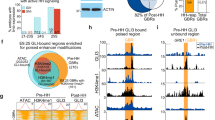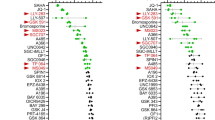Abstract
Tibial hemimelia is a rare, debilitating and often sporadic congenital deficiency. In syndromic cases, mutations of a Sonic hedgehog (SHH) enhancer have been identified. Here we describe an ~5 kb deletion within the SHH repressor GLI3 in two patients with bilateral tibial hemimelia. This deletion results in a truncated GLI3 protein that lacks a DNA-binding domain and cannot repress hedgehog signaling. These findings strengthen the concept that tibial hemimelia arises because of failure to restrict SHH activity to the posterior aspect of the limb bud.
Similar content being viewed by others
Log in or create a free account to read this content
Gain free access to this article, as well as selected content from this journal and more on nature.com
or
References
Evans, E. L. & Smith, N. R. Congenital absence of tibia. Arch. Dis. Child 1, 194–229 (1926).
Weber, M. New classification and score for tibial hemimelia. J. Child Orthop. 2, 169–175 (2008).
Carvalho, D. R., Santos, S. C., Oliveira, M. D. & Speck-Martins, C. E. Tibial hemimelia in Langer-Giedion syndrome with 8q23.1-q24.12 interstitial deletion. Am. J. Med. Genet. A 155A, 2784–2787 (2011).
Lezirovitz, K., Maestrelli, S. R., Cotrim, N. H., Otto, P. A., Pearson, P. L. & Mingroni-Netto, R. C. A novel locus for split-hand/foot malformation associated with tibial hemimelia (SHFLD syndrome) maps to chromosome region 17p13.1-17p13.3. Hum. Genet. 123, 625–631 (2008).
Agarwal, R. P., Jain, D., Ramesh Babu, C. S. & Garg, R. K. A hereditable combination of congenital anomalies. J. Bone Joint Surg. Br. 78, 492–494 (1996).
McKay, M., Clarren, S. K. & Zorn, R. Isolated tibial hemimelia in sibs: an autosomal-recessive disorder? Am. J. Med. Genet. 17, 603–607 (1984).
Akiyama, R., Kawakami, H., Wong, J., Oishi, I., Nishinakamura, R. & Kawakami, Y. Sall4-Gli3 system in early limb progenitors is essential for the development of limb skeletal elements. Proc. Natl Acad. Sci. USA 112, 5075–5080 (2015).
Li, D., Sakuma, R., Vakili, N. A., Mo, R., Puviindran, V., Deimling, S. et al. Formation of proximal and anterior limb skeleton requires early function of Irx3 and Irx5 and is negatively regulated by Shh signaling. Dev. Cell 29, 233–240 (2014).
Zhulyn, O., Li, D., Deimling, S., Vakili, N. A., Mo, R., Puviindran, V. et al. A switch from low to high Shh activity regulates establishment of limb progenitors and signaling centers. Dev. Cell 29, 241–249 (2014).
Cho, T. J., Baek, G. H., Lee, H. R., Moon, H. J., Yoo, W. J. & Choi, I. H. Tibial hemimelia-polydactyly-five-fingered hand syndrome associated with a 404 G>A mutation in a distant sonic hedgehog cis-regulator (ZRS): a case report. J. Pediatr. Orthop. B 22, 219–221 (2013).
Wieczorek, D., Pawlik, B., Li, Y., Akarsu, N. A., Caliebe, A., May, K. J. et al. A specific mutation in the distant sonic hedgehog (SHH) cis-regulator (ZRS) causes Werner mesomelic syndrome (WMS) while complete ZRS duplications underlie Haas type polysyndactyly and preaxial polydactyly (PPD) with or without triphalangeal thumb. Hum. Mutat. 31, 81–89 (2010).
VanderMeer, J. E., Lozano, R., Sun, M., Xue, Y., Daentl, D., Jabs, E. W. et al. A novel ZRS mutation leads to preaxial polydactyly type 2 in a heterozygous form and Werner mesomelic syndrome in a homozygous form. Hum. Mutat. 35, 945–948 (2014).
Lettice, L. A., Hill, A. E., Devenney, P. S. & Hill, R. E. Point mutations in a distant sonic hedgehog cis-regulator generate a variable regulatory output responsible for preaxial polydactyly. Hum. Mol. Genet. 17, 978–985 (2008).
MacDonald, J. R., Ziman, R., Yuen, R. K., Feuk, L. & Scherer, S. W. The Database of Genomic Variants: a curated collection of structural variation in the human genome. Nucleic Acids Res. 42, D986–D992 (2014).
Shalaby, F., Rossant, J., Yamaguchi, T. P., Gertsenstein, M., Wu, X. F., Breitman, M. L. et al. Failure of blood-island formation and vasculogenesis in Flk-1-deficient mice. Nature 376, 62–66 (1995).
Wang, C., Ruther, U. & Wang, B. The Shh-independent activator function of the full-length Gli3 protein and its role in vertebrate limb digit patterning. Dev. Biol. 305, 460–469 (2007).
Litingtung, Y., Dahn, R. D., Li, Y., Fallon, J. F. & Chiang, C. Shh and Gli3 are dispensable for limb skeleton formation but regulate digit number and identity. Nature 418, 979–983 (2002).
Zuniga, A., Zeller, R. & Probst, S. The molecular basis of human congenital limb malformations. Wiley Interdiscip. Rev. Dev. Biol. 1, 803–822 (2012).
Acknowledgements
We thank Drs Christian Marshall, Steven Scherer, Sergio Pereira and Chao Lu, and Ms Sylvia Lamoureux from the Centre for Applied Genomics at the Hospital for Sick Children for their valuable advice. This project was supported by the March of Dimes Research Grant 1-FY10-366, Stem Cell Innovation Grant, Hospital for Sick Children and Canadian Institutes of Health Research Operating Grant 137092 (C-cH and SH).
Author information
Authors and Affiliations
Corresponding author
Ethics declarations
Competing interests
The authors declare no conflict of interest.
Rights and permissions
About this article
Cite this article
Deimling, S., Sotiropoulos, C., Lau, K. et al. Tibial hemimelia associated with GLI3 truncation. J Hum Genet 61, 443–446 (2016). https://doi.org/10.1038/jhg.2015.161
Received:
Revised:
Accepted:
Published:
Issue date:
DOI: https://doi.org/10.1038/jhg.2015.161
This article is cited by
-
A novel smoothed (SMO) point mutation in congenital tibial hemimelia: a case report
BMC Pediatrics (2023)
-
Compound heterozygous GLI3 variants in siblings with thyroid hemiagenesis
Endocrine (2021)
-
GLI3: a mediator of genetic diseases, development and cancer
Cell Communication and Signaling (2020)
-
Constant inhibition in congenital lower extremity shortening: does it begin in utero?
Pediatric Radiology (2018)
-
Systematic radiographic evaluation of tibial hemimelia with orthopedic implications
Pediatric Radiology (2017)



